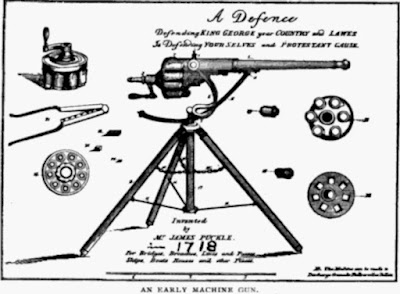The first guns that had the ability to fire multiple shots from a single barrel without a full manual reload were revolvers made in Europe in the late 1500s.
On May 15, 1718, an English lawyer, James Puckle, patented the first machine gun. The "Puckle Gun" could be adjusted to fire round bullets at Christians and square bullets at Turks. A keen fisherman, Puckle intended to use it at sea.
The picture below is the flier for James Puckle's 1718 patent revolving firearm, showing various cylinders for use with round and square bullets.
The first rapid-fire machine gun was patented by Richard Jordan Gatting of Indianapolis in 1861. Gatling wrote that he created it to reduce the size of armies and so reduce the number of deaths by combat and disease, and to show how futile war is.
If General Custer had placed more confidence in the Gattling machine guns he possessed instead of deliberately leaving them behind at HQ, Custer's last stand might been Custer's successful stand.
Hiram Maxim (February 5, 1840 – November 24, 1916), the London-based American who invented the world's first portable fully automatic machine gun in 1884, was supposedly inspired by an American friend, who said the route to riches was to "invent something that will enable these Europeans to cut each other's throats with greater facility".
Sadly it worked: Maxim's brutally efficient guns were adopted by several armies and its successors inflicted horrific casualties in the First World War. They worked so well - firing up to 600 rounds a minute - that some believed the weapon would end war altogether.
On May 15, 1718, an English lawyer, James Puckle, patented the first machine gun. The "Puckle Gun" could be adjusted to fire round bullets at Christians and square bullets at Turks. A keen fisherman, Puckle intended to use it at sea.
The picture below is the flier for James Puckle's 1718 patent revolving firearm, showing various cylinders for use with round and square bullets.
 |
| Flier for James Puckle's 1718 patent |
The first rapid-fire machine gun was patented by Richard Jordan Gatting of Indianapolis in 1861. Gatling wrote that he created it to reduce the size of armies and so reduce the number of deaths by combat and disease, and to show how futile war is.
If General Custer had placed more confidence in the Gattling machine guns he possessed instead of deliberately leaving them behind at HQ, Custer's last stand might been Custer's successful stand.
Hiram Maxim (February 5, 1840 – November 24, 1916), the London-based American who invented the world's first portable fully automatic machine gun in 1884, was supposedly inspired by an American friend, who said the route to riches was to "invent something that will enable these Europeans to cut each other's throats with greater facility".
 |
| Maxim machine gun in the Georgian National Museum By Jonathan Cardy - |
Sadly it worked: Maxim's brutally efficient guns were adopted by several armies and its successors inflicted horrific casualties in the First World War. They worked so well - firing up to 600 rounds a minute - that some believed the weapon would end war altogether.
Hiram Maxim spent so much time test-firing his guns that he became completely deaf. His son Hiram Percy Maxim eventually invented the silencer, but too late to save his father's hearing.
A prolific inventor, Maxim was also responsible for creating the world’s first automatic sprinkler to douse fires and the common mousetrap.
A prolific inventor, Maxim was also responsible for creating the world’s first automatic sprinkler to douse fires and the common mousetrap.
In 1917 you could order a belt-fed machine gun from a Sears catalog: "Machine guns are used largely by police organizations, home guards and municipalities in case of riots."
The world's first sub-machine gun was the MP18.1, invented by Theodor Bergmann. It was introduced into service in 1918 by the German Army during World War I.
The World War I Vickers Machine Gun, used by the British from 1913-1968, was remarkably reliable. In one action that took place in August 1916, the British 100th Company of the Machine Gun Corps fired their ten Vickers guns continuously for twelve hours. Using 100 barrels, they fired a million rounds without a failure.
In 1963, the British army tested how long a World War I Vickers Machine Gun could fire. The test was conducted at Strensall Barracks in Yorkshire, England in 1963. A newly rebuilt Vickers gun was fired for seven days straight, firing a total of just under 5 million rounds. The gun was still operable at the end of the test, and it showed no signs of significant wear or damage.
When she was a young woman, sex therapist Dr. Ruth Westheimer once lived in Israel. There, she was a trained sniper. She was so adept at handling a Sten gun — a British submachine gun — that she could quickly assemble one while blindfolded.
A fully automatic Thompson submachine gun can fire up to 900 rounds per minute.
Source The Independent
No comments:
Post a Comment